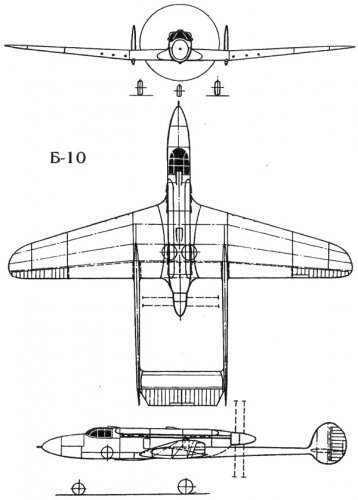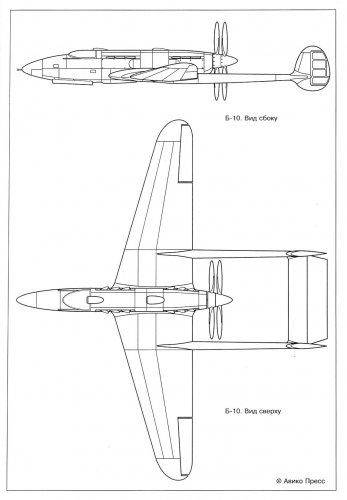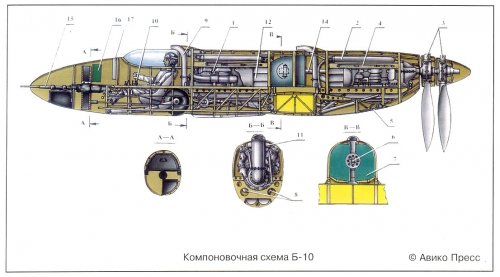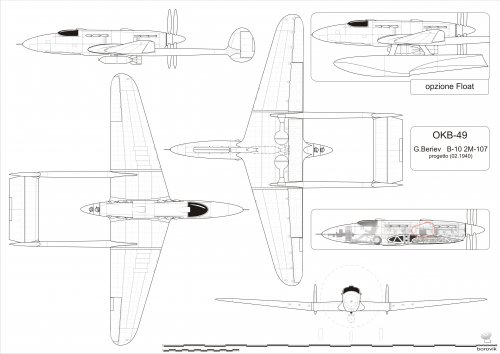You are using an out of date browser. It may not display this or other websites correctly.
You should upgrade or use an alternative browser.
You should upgrade or use an alternative browser.
Beriev B-10 fighter project
- Thread starter Skyraider3D
- Start date
- Joined
- 22 January 2006
- Messages
- 3,891
- Reaction score
- 1,150
Re: Bolkhovitinov B-10 fighter project
Most R-40C contenders were supposed to do that but prototypes (XP-54, XP-55, XP-56) shown speeds far below that figures. And I don't want to mention some "Luft 46" designs. Some engineers are very optimistic about their work
It was supposed to achieve 800 km/h!
Most R-40C contenders were supposed to do that but prototypes (XP-54, XP-55, XP-56) shown speeds far below that figures. And I don't want to mention some "Luft 46" designs. Some engineers are very optimistic about their work
- Joined
- 7 June 2009
- Messages
- 525
- Reaction score
- 127
Re: Bolkhovitinov B-10 fighter project
It is Beriev project, not Bolkhovitinov! Yes, one from very few land-based aircrafts (and perhaps the only fighter) from the renowned seaplane designer! Georgi Beriev offered it to NKAP at the middle of February 1940. He claimed that his project of experimental high-speed fighter embodied maximum of newest achievements in aircraft engineering, such as tandem engine mounting (reduces the aerodynamic drag very much in comparison to conventional twin-engine layout), laminar airfoil profile (which, according to calculations, could give 46 km/h speed increase), contraprops (annihilate the reaction torque, reduce the necessary propeller diameter), etc. But the project wasn't confirmed and developed further - maybe it was regarded too risky, and proclaimed flight performances too optimistic...
Technical data for Beriev B-10 (projected):
Wingspan - 13.0 m
Length - 11.26 m
Height - 2.75 m
Wing area - 26 m2
Flight weight - 3870 kg
Crew - 1
Powerplant - two Klimov M-107 engines, twinned, 1050 hp each
Maximum speed - 818 km/h at 8000 m altitude (!!!), 750 km/h near the ground
Landing speed - 126 km/h
Service ceiling - 11 570 m
Flight range - 1950 km
Armament - one 20-mm ShVAK cannon (nose-mounted), six 7.62-mm ShKAS machine guns (wing mounted). One 250-kg FAB-250 bomb when overload.
Source: Панатов Г.С., Удалов К.Г. Иллюстрировання энциклопедия самолётов ТАНТК им. Г.М. Бериева. Т.1. М., Авико-Пресс, 1998 (G. Panatov, K. Udalov. Illustrated encyclopedia of Beriev TANTK aircraft. Vol.1 - Moscow, Avico-Press, 1998).
It is Beriev project, not Bolkhovitinov! Yes, one from very few land-based aircrafts (and perhaps the only fighter) from the renowned seaplane designer! Georgi Beriev offered it to NKAP at the middle of February 1940. He claimed that his project of experimental high-speed fighter embodied maximum of newest achievements in aircraft engineering, such as tandem engine mounting (reduces the aerodynamic drag very much in comparison to conventional twin-engine layout), laminar airfoil profile (which, according to calculations, could give 46 km/h speed increase), contraprops (annihilate the reaction torque, reduce the necessary propeller diameter), etc. But the project wasn't confirmed and developed further - maybe it was regarded too risky, and proclaimed flight performances too optimistic...
Technical data for Beriev B-10 (projected):
Wingspan - 13.0 m
Length - 11.26 m
Height - 2.75 m
Wing area - 26 m2
Flight weight - 3870 kg
Crew - 1
Powerplant - two Klimov M-107 engines, twinned, 1050 hp each
Maximum speed - 818 km/h at 8000 m altitude (!!!), 750 km/h near the ground
Landing speed - 126 km/h
Service ceiling - 11 570 m
Flight range - 1950 km
Armament - one 20-mm ShVAK cannon (nose-mounted), six 7.62-mm ShKAS machine guns (wing mounted). One 250-kg FAB-250 bomb when overload.
Source: Панатов Г.С., Удалов К.Г. Иллюстрировання энциклопедия самолётов ТАНТК им. Г.М. Бериева. Т.1. М., Авико-Пресс, 1998 (G. Panatov, K. Udalov. Illustrated encyclopedia of Beriev TANTK aircraft. Vol.1 - Moscow, Avico-Press, 1998).
Re: Bolkhovitinov B-10 fighter project
Yes, very optmitic, with that armament and only two engines of 1050 Hp : 818 km/h ......
If this planes was built the real speed could be been 650-700 not 818
Yes, very optmitic, with that armament and only two engines of 1050 Hp : 818 km/h ......
If this planes was built the real speed could be been 650-700 not 818
Skyraider3D
Aviation Artist
Thanks very much for the info and correction, Alexander. I have changed the subject title accordingly.
Indeed I "read" this info from a Russian-language source, which mentioned the Bolkhovitinov I-1 proposal in the same paragraph. That combined with the tandem engine layout resulted in the confusion. I did read elsewhere on this forum about a Beriev B-10 project from 1940, but I half assumed it was a flying boat! ;D
Hehe, I know a lot of the early-war designs were very optimistic in their speed quotes, as compressibility effects and increased drag related to high speed weren't fully understood. Around 700 km/h seems to have been the limit for almost all of these. Saab managed to squeeze 640 km/h our of their Model 21 with just 1455 hp, which is better than most conventional aircraft of similar horsepower, but not exceptional.
Speaking of optimistic estimates and Luft'46, somewhere I have scans of the design documents of the Triebflügeljäger. It is quoted with a top speed of 1000 km/h at sea level. Now I'd like to see that!
Indeed I "read" this info from a Russian-language source, which mentioned the Bolkhovitinov I-1 proposal in the same paragraph. That combined with the tandem engine layout resulted in the confusion. I did read elsewhere on this forum about a Beriev B-10 project from 1940, but I half assumed it was a flying boat! ;D
Hehe, I know a lot of the early-war designs were very optimistic in their speed quotes, as compressibility effects and increased drag related to high speed weren't fully understood. Around 700 km/h seems to have been the limit for almost all of these. Saab managed to squeeze 640 km/h our of their Model 21 with just 1455 hp, which is better than most conventional aircraft of similar horsepower, but not exceptional.
Speaking of optimistic estimates and Luft'46, somewhere I have scans of the design documents of the Triebflügeljäger. It is quoted with a top speed of 1000 km/h at sea level. Now I'd like to see that!
Bailey
ACCESS: Secret
- Joined
- 24 July 2009
- Messages
- 308
- Reaction score
- 34
Have a look at this older thread as well....
http://www.secretprojects.co.uk/forum/index.php/topic,4532.0
Regards Bailey
http://www.secretprojects.co.uk/forum/index.php/topic,4532.0
Regards Bailey
- Joined
- 7 June 2009
- Messages
- 525
- Reaction score
- 127
airman said:Yes, very optmitic, with that armament and only two engines of 1050 Hp : 818 km/h ......
If this planes was built the real speed could be been 650-700 not 818
Oh, 1050 hp seems to be a mistake... Yes, this value is given in the book I mentioned, but 1050 hp was a power of the M-105 engine. The M-107, even in its first version, had 1300-1400 hp (when it at least came into production as VK-107A, its power was increased to 1500 / 1650 hp (1500 nominal, 1650 takeoff)).
And I found some additional info in Mikhail Maslov's book The Lost Victories of Soviet Aviation. I had a mistake in my first post - the project wasn't rejected! The GUAS KA (Chief department for aviation supply of Red Army) discussed it and decided that it is realistic enough to be included into the schedule for 1941. But the Beriev OKB was too busy with seaplane projects, and had no experience with fighters / high-speed aircrafts / landplanes. Therefore, it was decided to transfer this project for further development... to Bolkhovitinov, because of his experience with similar tandem-twinned engines. So, Skyraider3D, you wasn't so wrong - this aircraft became Bolkhovitinov at least. But at that time it already wasn't called B-10: in Bolkhovitinov OKB it was redesignated as Aircraft "I". Chief designer of the theme in Bolkhovitinov's team was Alexei Isaev - the man who later, together with Alexander Bereznyak, designed the well-known "BI" rocket interceptor.
The "I" was similar to its Beriev precursor, but some changes were made. Its distinctive feature was "wet wing" like that of Seversky P-35, but made from Elektron (a magnesium alloy). The wing area was reduced to 20 m2, and the engines replaced with M-105 (there were some problems in M-107 development). With M-105 engines, calculated maximum speed was 675 km/h.
The project was developed until March 21, 1941, when it was cancelled together with some other experimental works.
Skyraider3D
Aviation Artist
Excellent info, Alexander. The new speed calculation of 675 km/h seems more reasonable indeed.

O my... a floatplane version as well!Bailey said:Have a look at this older thread as well....
http://www.secretprojects.co.uk/forum/index.php/topic,4532.0
Ok, then with M-107 there was 3000 Hp - 3300 Hp takeoff ,redstar72 said:airman said:Yes, very optmitic, with that armament and only two engines of 1050 Hp : 818 km/h ......
If this planes was built the real speed could be been 650-700 not 818
Oh, 1050 hp seems to be a mistake... Yes, this value is given in the book I mentioned, but 1050 hp was a power of the M-105 engine. The M-107, even in its first version, had 1300-1400 hp (when it at least came into production as VK-107A, its power was increased to 1500 / 1650 hp (1500 nominal, 1650 takeoff)).
And I found some additional info in Mikhail Maslov's book The Lost Victories of Soviet Aviation. I had a mistake in my first post - the project wasn't rejected! The GUAS KA (Chief department for aviation supply of Red Army) discussed it and decided that it is realistic enough to be included into the schedule for 1941. But the Beriev OKB was too busy with seaplane projects, and had no experience with fighters / high-speed aircrafts / landplanes. Therefore, it was decided to transfer this project for further development... to Bolkhovitinov, because of his experience with similar tandem-twinned engines. So, Skyraider3D, you wasn't so wrong - this aircraft became Bolkhovitinov at least. But at that time it already wasn't called B-10: in Bolkhovitinov OKB it was redesignated as Aircraft "I". Chief designer of the theme in Bolkhovitinov's team was Alexei Isaev - the man who later, together with Alexander Bereznyak, designed the well-known "BI" rocket interceptor.
The "I" was similar to its Beriev precursor, but some changes were made. Its distinctive feature was "wet wing" like that of Seversky P-35, but made from Elektron (a magnesium alloy). The wing area was reduced to 20 m2, and the engines replaced with M-105 (there were some problems in M-107 development). With M-105 engines, calculated maximum speed was 675 km/h.
The project was developed until March 21, 1941, when it was cancelled together with some other experimental works.
Problems of deveploment of M-107 : mhhhmmm problems about cooling system ?
- Joined
- 7 June 2009
- Messages
- 525
- Reaction score
- 127
airman said:Problems of deveploment of M-107 : mhhhmmm problems about cooling system ?
No, they were rather problems with reliable work of the engine itself and its service life. M-107 was augmented too much, its power density reached about 43 hp per litre (nominal; 47 takeoff), which of course wasn't good for the reliability. Even when VK-107A came into production, its guaranted service life was only 25 hours! The engine had Battle Regime but pilots tried not to use it, because its applying reduced the service life even more.
- Joined
- 7 June 2009
- Messages
- 525
- Reaction score
- 127
Skyraider3D
Aviation Artist
Very cool, thanks for posting! B)
very nice pictures ! B)redstar72 said:Some pictures from Panatov & Udalov book:
blackkite
Don't laugh, don't cry, don't even curse, but.....
- Joined
- 31 May 2007
- Messages
- 8,286
- Reaction score
- 5,840
Hi! Бериев Б-10(Beriev B-10)
http://aviadejavu.ru/Site/Crafts/Craft28310.htm
http://alternathistory.com/ivnamin-sultanov-skorostnoi-istrebitel-b-10-10
http://translate.google.fr/translate?hl=fr&sl=ru&tl=en&u=http%3A%2F%2Falternathistory.com%2Fivnamin-sultanov-skorostnoi-istrebitel-b-10-10&sandbox=1
"Improved radiator group was placed in the compartment between the motors, and, finally, radically changed the chassis, which received front rack." ???
http://www.docvid.ru/tiazhelie-istrebiteli-vtoroy-mirovoy/beriev-b-10.html
"Improved Panel radiator was placed in a compartment between motors and, finally, radically changed the chassis, which got the front rack. It was removed under the pilot's cabin, and its wheel behind the pilot." ???
http://www.secretprojects.co.uk/forum/index.php?action=dlattach;topic=8439.0;attach=86957;image
http://www.secretprojects.co.uk/forum/index.php?action=dlattach;topic=8439.0;attach=86963;image
http://aviadejavu.ru/Site/Crafts/Craft28310.htm
http://alternathistory.com/ivnamin-sultanov-skorostnoi-istrebitel-b-10-10
http://translate.google.fr/translate?hl=fr&sl=ru&tl=en&u=http%3A%2F%2Falternathistory.com%2Fivnamin-sultanov-skorostnoi-istrebitel-b-10-10&sandbox=1
"Improved radiator group was placed in the compartment between the motors, and, finally, radically changed the chassis, which received front rack." ???
http://www.docvid.ru/tiazhelie-istrebiteli-vtoroy-mirovoy/beriev-b-10.html
"Improved Panel radiator was placed in a compartment between motors and, finally, radically changed the chassis, which got the front rack. It was removed under the pilot's cabin, and its wheel behind the pilot." ???
http://www.secretprojects.co.uk/forum/index.php?action=dlattach;topic=8439.0;attach=86957;image
http://www.secretprojects.co.uk/forum/index.php?action=dlattach;topic=8439.0;attach=86963;image
Attachments
lucamax
ACCESS: Secret
Dear,
I apologize if I open an OT, but in the link posted by Blackkite (http://www.docvid.ru/tiazhelie-istrebiteli-vtoroy-mirovoy/beriev-b-10.html) there is the draw I post below: can anyone explain it? Is it an early projeckt of the Beriev B-10?
Thanks a lot!
Greetings.
I apologize if I open an OT, but in the link posted by Blackkite (http://www.docvid.ru/tiazhelie-istrebiteli-vtoroy-mirovoy/beriev-b-10.html) there is the draw I post below: can anyone explain it? Is it an early projeckt of the Beriev B-10?
Thanks a lot!
Greetings.
Attachments
blackkite
Don't laugh, don't cry, don't even curse, but.....
- Joined
- 31 May 2007
- Messages
- 8,286
- Reaction score
- 5,840
Ummm.....May be this one?
http://www.secretprojects.co.uk/forum/index.php?action=dlattach;topic=12185.0;attach=129889;image
http://www.secretprojects.co.uk/forum/index.php/topic,12185.0/all.html
http://www.secretprojects.co.uk/forum/index.php?action=dlattach;topic=12185.0;attach=129889;image
http://www.secretprojects.co.uk/forum/index.php/topic,12185.0/all.html
blackkite
Don't laugh, don't cry, don't even curse, but.....
- Joined
- 31 May 2007
- Messages
- 8,286
- Reaction score
- 5,840
Hi!
https://www.ecured.cu/Polikarpov_SI
"Polikarpov SI / TsKB-21 (Russian: Поликарпов СИ / ЦКБ-21) - High-speed hunting project conceived in 1935 to set a world record. The design would be resumed by Beriev in 1939 to turn it into the B-10 .
History
The history of this aircraft begins on May 7, 1935 , when the replacement of the GUAP chief, BB Margolin, asked the head of the TsKB of the No.39 SV Ilyushin Factory to study the possibility of creating an airplane capable of breaking the world record Of speed as the slogan launched by Stalin : "Flying faster, higher and further away" began precisely with "faster . "
The other tasks "higher" and "farther" were moving at a good pace. The unofficial height record had been established by the Soviets on January 21 , 1935, when it reached 14575 m. There had also been important long-haul flights that had received world attention, but of speed - nothing.
The task was assigned to the brigade led by NN Polikarpov , who was engaged in the development of fighters.
Project study
After the evaluation of the possible power plant it was finally decided to use a paired engine composed of two M-100s (Soviet version of Hispano-Suiza 12Y) attached through the shaft.
The new project was named SI, according to the acronym of Skorostnoi Istrebitel or Fast Chase and the number TsKB-21 in the internal register of TsKB .
Description
The SI hunt was conceived as a low-wing aircraft with double tail cone, double feathering and retractable landing gear.
In the centroplane the central gondola was installed. The tandem installation of the two engines, in order to facilitate the installation of the armament, placed them with the rear axles, moving two propellers counterrotatorias in configuration impeller of 2.85 m in diameter. In the bow section a ShVAK cannon was installed under the cockpit and six ShKAS machine guns were mounted on the wings.
In the development of this project they had a participation protagonist VK Tairov . And MR Bisnovat .
Transfer of the project
For the new TsKB-21 fighter it was decided to install a train with floats and according to the opinion of the TsKB leadership this task was better suited to Brigade No.3 directed by Beriev . In 1933 that brigade had been located in Taganrog , closer to the sea. Beriev was working on the development of the MBR-2 reconnaissance float, which had already been debated in Moscow , at Factory No.39.
The float project for the TsKB-21 was kept waiting on what worked on the hydrocanoa. When finally this model went into production the record hunt had been totally forgotten not only by those responsible, but also by those who had requested their development.
Renaissance
The SI project was revitalized at OKB-31 Beriev in 1939 . At that time the new slogan of the aeronautical construction was "To obtain the best fast hunt" . For this reason in January 1940 the old SI project (TsKB-21) would be converted into the Beriev B-10 high speed fighter, armed by the same ShVAK cannon and the same ShKAS machine guns . The main difference would be the selected power plant, in this case the Klimov M-107 of 1250/1400 hp.
Technical specifications
(Calculated)
• Function: High-speed hunting project
• Year: 1935
• Power plant: 2 paired M-100 860 hp engines
• Accommodation: 1
• DIMENSIONS ◦ Surface area: 26.6 m²
• WEIGHTS AND LOADS
◦ Weight: 1518 kg
◦ Maximum take-off weight: 2930 kg
◦ Fuel capacity: 280 - 300 kg
• BENEFITS
◦ Maximum speed: km / h
◦ Flight ceiling: 9000 - 10000 m
◦ Ascent time to 5000 m: 5.5 min
◦ Maximum range: 1350 km
• Weapon: Two 23 mm guns.
https://www.ecured.cu/Polikarpov_SI
"Polikarpov SI / TsKB-21 (Russian: Поликарпов СИ / ЦКБ-21) - High-speed hunting project conceived in 1935 to set a world record. The design would be resumed by Beriev in 1939 to turn it into the B-10 .
History
The history of this aircraft begins on May 7, 1935 , when the replacement of the GUAP chief, BB Margolin, asked the head of the TsKB of the No.39 SV Ilyushin Factory to study the possibility of creating an airplane capable of breaking the world record Of speed as the slogan launched by Stalin : "Flying faster, higher and further away" began precisely with "faster . "
The other tasks "higher" and "farther" were moving at a good pace. The unofficial height record had been established by the Soviets on January 21 , 1935, when it reached 14575 m. There had also been important long-haul flights that had received world attention, but of speed - nothing.
The task was assigned to the brigade led by NN Polikarpov , who was engaged in the development of fighters.
Project study
After the evaluation of the possible power plant it was finally decided to use a paired engine composed of two M-100s (Soviet version of Hispano-Suiza 12Y) attached through the shaft.
The new project was named SI, according to the acronym of Skorostnoi Istrebitel or Fast Chase and the number TsKB-21 in the internal register of TsKB .
Description
The SI hunt was conceived as a low-wing aircraft with double tail cone, double feathering and retractable landing gear.
In the centroplane the central gondola was installed. The tandem installation of the two engines, in order to facilitate the installation of the armament, placed them with the rear axles, moving two propellers counterrotatorias in configuration impeller of 2.85 m in diameter. In the bow section a ShVAK cannon was installed under the cockpit and six ShKAS machine guns were mounted on the wings.
In the development of this project they had a participation protagonist VK Tairov . And MR Bisnovat .
Transfer of the project
For the new TsKB-21 fighter it was decided to install a train with floats and according to the opinion of the TsKB leadership this task was better suited to Brigade No.3 directed by Beriev . In 1933 that brigade had been located in Taganrog , closer to the sea. Beriev was working on the development of the MBR-2 reconnaissance float, which had already been debated in Moscow , at Factory No.39.
The float project for the TsKB-21 was kept waiting on what worked on the hydrocanoa. When finally this model went into production the record hunt had been totally forgotten not only by those responsible, but also by those who had requested their development.
Renaissance
The SI project was revitalized at OKB-31 Beriev in 1939 . At that time the new slogan of the aeronautical construction was "To obtain the best fast hunt" . For this reason in January 1940 the old SI project (TsKB-21) would be converted into the Beriev B-10 high speed fighter, armed by the same ShVAK cannon and the same ShKAS machine guns . The main difference would be the selected power plant, in this case the Klimov M-107 of 1250/1400 hp.
Technical specifications
(Calculated)
• Function: High-speed hunting project
• Year: 1935
• Power plant: 2 paired M-100 860 hp engines
• Accommodation: 1
• DIMENSIONS ◦ Surface area: 26.6 m²
• WEIGHTS AND LOADS
◦ Weight: 1518 kg
◦ Maximum take-off weight: 2930 kg
◦ Fuel capacity: 280 - 300 kg
• BENEFITS
◦ Maximum speed: km / h
◦ Flight ceiling: 9000 - 10000 m
◦ Ascent time to 5000 m: 5.5 min
◦ Maximum range: 1350 km
• Weapon: Two 23 mm guns.
Attachments
blackkite
Don't laugh, don't cry, don't even curse, but.....
- Joined
- 31 May 2007
- Messages
- 8,286
- Reaction score
- 5,840
redstar72-san, please show me the name of each parts.(1 to 17)
I assume that....
1 : Engine, 2 : Camshaft, 3 : Propeller, 4 : Exhaust nozzles, 5 : Speed brake, 7 : Fuel tank, 9 : Engine ram air intake, 10 : Control rod,
12 : Improved Panel radiator, 14 : Propeller drive shaft, 15 : Cannon
I assume that....
1 : Engine, 2 : Camshaft, 3 : Propeller, 4 : Exhaust nozzles, 5 : Speed brake, 7 : Fuel tank, 9 : Engine ram air intake, 10 : Control rod,
12 : Improved Panel radiator, 14 : Propeller drive shaft, 15 : Cannon













